Skip to main contentXABCD Pattern
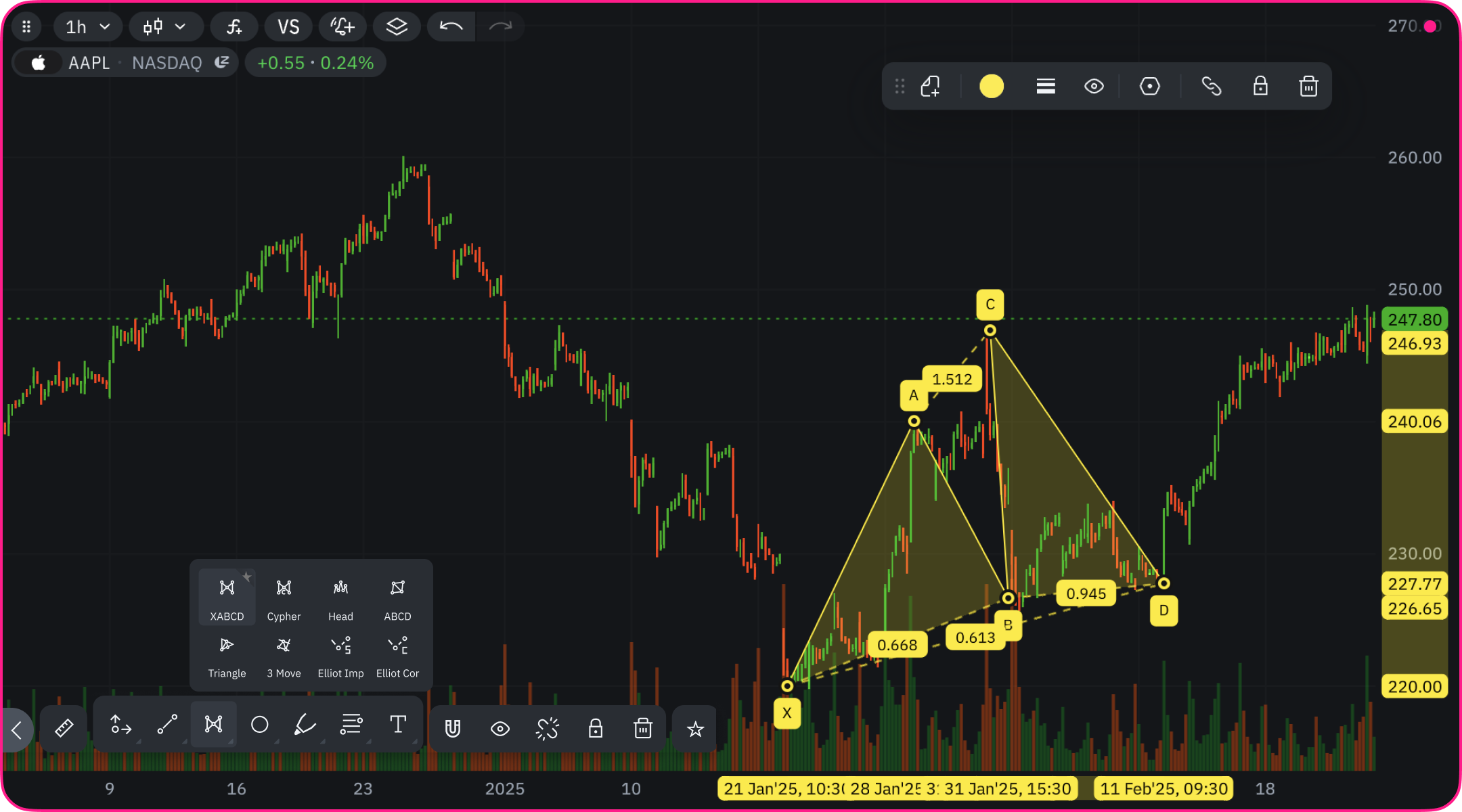 A powerful tool for harmonic pattern analysis:
A powerful tool for harmonic pattern analysis:
- Basic Structure:
- Five control points (X, A, B, C, D)
- Four connecting legs (XA, AB, BC, CD)
- Each point represents significant price high or low
- Adjacent legs move in opposite directions
- Identified Patterns:
Four major harmonic patterns with bullish or bearish variations:
- Gartley
- Butterfly
- Crab
- Bat
- Usage:
- Manually position five points at key swing highs/lows
- Adjust points to match specific pattern requirements
- Analyze potential reversal zones
- Identify potential price targets
- Customization:
- Adjust point positions
- Change line properties
- Modify pattern colors
Cypher Pattern
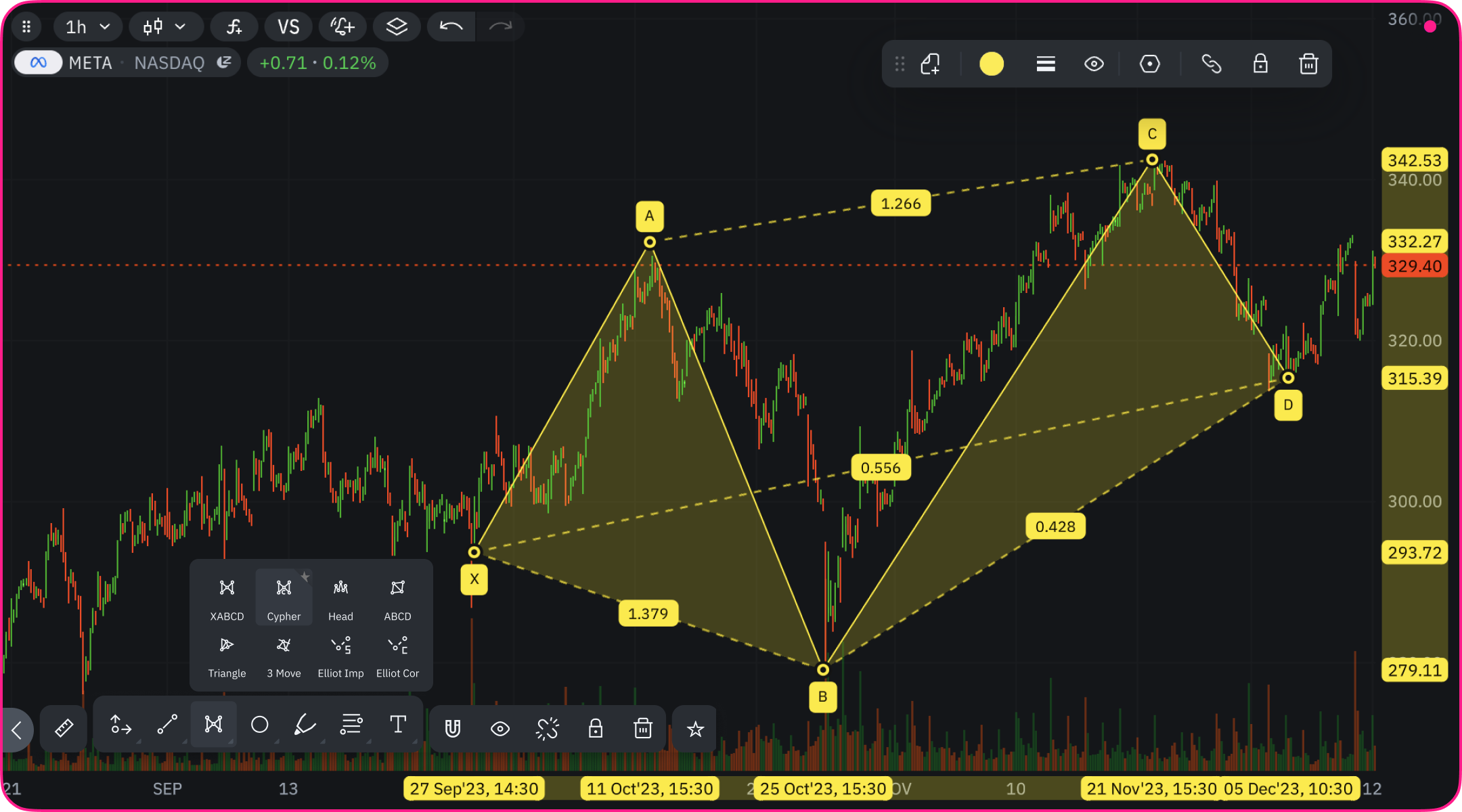 A precise harmonic pattern for identifying high-probability reversal points:
A precise harmonic pattern for identifying high-probability reversal points:
- Origin: Developed by Darren Oglesbee
- Structure: Five key points (X, A, B, C, D) forming four legs
- Key Feature: Highly accurate Potential Reversal Zone (PRZ)
Pattern Structure
- XA leg: Initial price movement
- AB leg: First correction after XA move
- BC leg: Price movement following the correction
- CD leg: Final move to the reversal point D
- PRZ (Potential Reversal Zone): Located in XD region with Fibonacci ratio 0.768-0.886
Pattern Variations
- Bullish Cypher:
- Forms an M-shaped pattern
- Indicates upcoming uptrend after correction
- Entry point at D for long positions
- Bearish Cypher:
- Forms a W-shaped pattern
- Signals beginning of downtrend after temporary rise
- Entry point at D for short positions
Identification Tips
- Use Fibonacci tools to confirm ratio relationships
- Look for precise geometric formations
- Confirm with additional indicators at point D
- Watch for reversal candlestick patterns at PRZ
Head and Shoulders Pattern
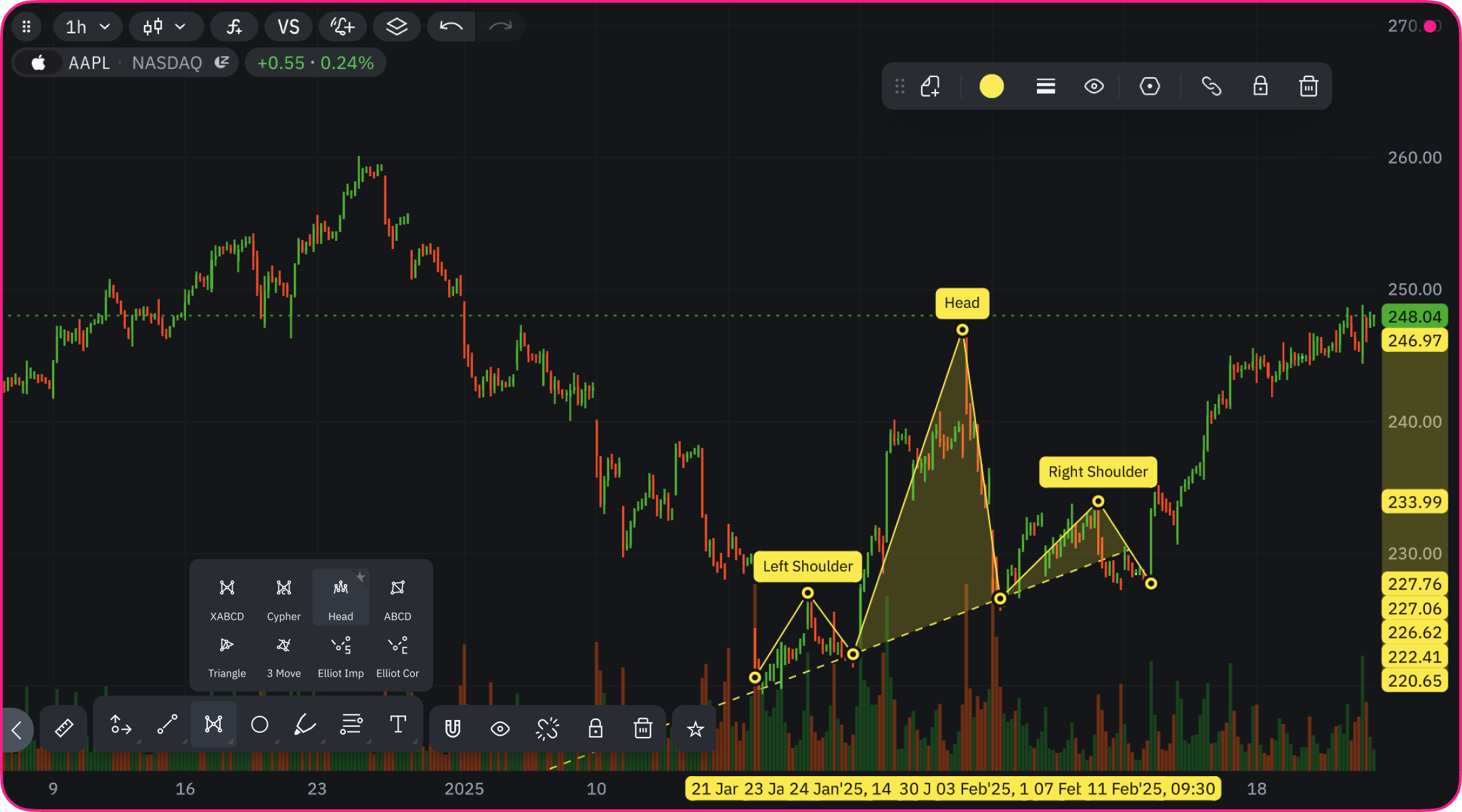 A classic reversal pattern signaling trend change:
Structure: Three distinct components with connecting neckline
A classic reversal pattern signaling trend change:
Structure: Three distinct components with connecting neckline
- Left shoulder
- Head (central peak/trough)
- Right shoulder
- Neckline (horizontal support/resistance)
Pattern Variations:
- Bearish Head and Shoulders:
- Forms at market tops
- Signals upcoming downtrend
- Head higher than both shoulders
- Bullish Head and Shoulders (Inverse):
- Forms at market bottoms
- Signals upcoming uptrend
- Head lower than both shoulders
Key Formation Elements:
- Previous Trend: Must form after established trend
- Left Shoulder: Initial peak/trough with high volume
- Head: Higher peak (or lower trough) than shoulders
- Right Shoulder: Similar height to left shoulder
- Neckline: Connecting line of support/resistance
- Volume: Typically decreases throughout formation
Confirmation:
- Price breaks neckline after right shoulder
- Bearish: Break below neckline
- Bullish: Break above neckline
- Often accompanied by volume increase
ABCD Pattern
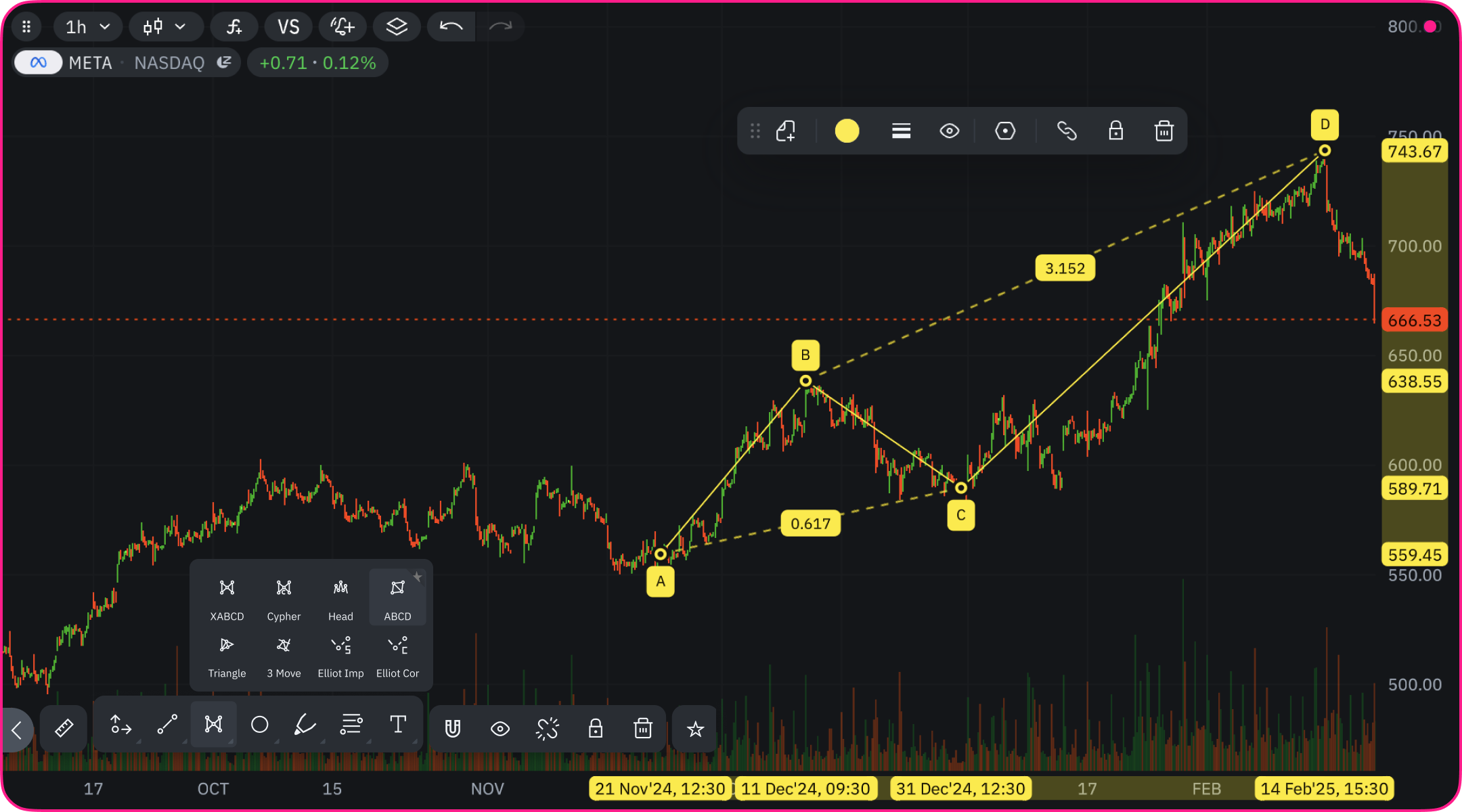 A versatile four-point pattern for identifying potential reversal zones:
Basic Structure:
A versatile four-point pattern for identifying potential reversal zones:
Basic Structure:
- Four control points (A, B, C, D)
- Three connecting legs (AB, BC, CD)
- Adjacent legs move in opposite directions
- Points mark significant highs and lows
Pattern Formation:
- First leg (AB): Initial price movement
- Second leg (BC): Retracement of first move
- Third leg (CD): Final move to completion point
- These three legs combine to create recognizable price structures that signal potential reversals
Major Pattern Variations:
- AB=CD Pattern:
- Distance of AB approximately equals CD
- Time duration of AB similar to CD
- Creates symmetrical price movements
- Signals potential reversal at point D
- Classic ABCD:
- CD leg extends 127.2% or 161.8% of BC leg
- Uses key Fibonacci extension levels
- Often forms in trending markets
- ABCD Extension:
- CD leg extends 127.2% or 161.8% of AB leg
- Focuses on relationship between first and last legs
- Potentially stronger reversal signals
Understanding Ratio Display:
The number shown between B&D represents the ratio of the CD leg relative to the BC distance. For example, when you see “127.9%” on the pattern, it means point D extends beyond point B by 27.9% of the BC distance. This corresponds to the 1.279 Fibonacci extension level (100% + 27.9%).
Fibonacci Percentages:
The values 127.2% and 161.8% are Fibonacci extension levels derived from mathematical relationships found throughout nature and markets. These specific ratios help determine the likely extension of the CD leg based on previous price movements.
Learn More: For detailed trading strategies and practical examples of the ABCD pattern, check out our comprehensive guide at Harmonic Pattern ABCD Education.
Triangle Pattern
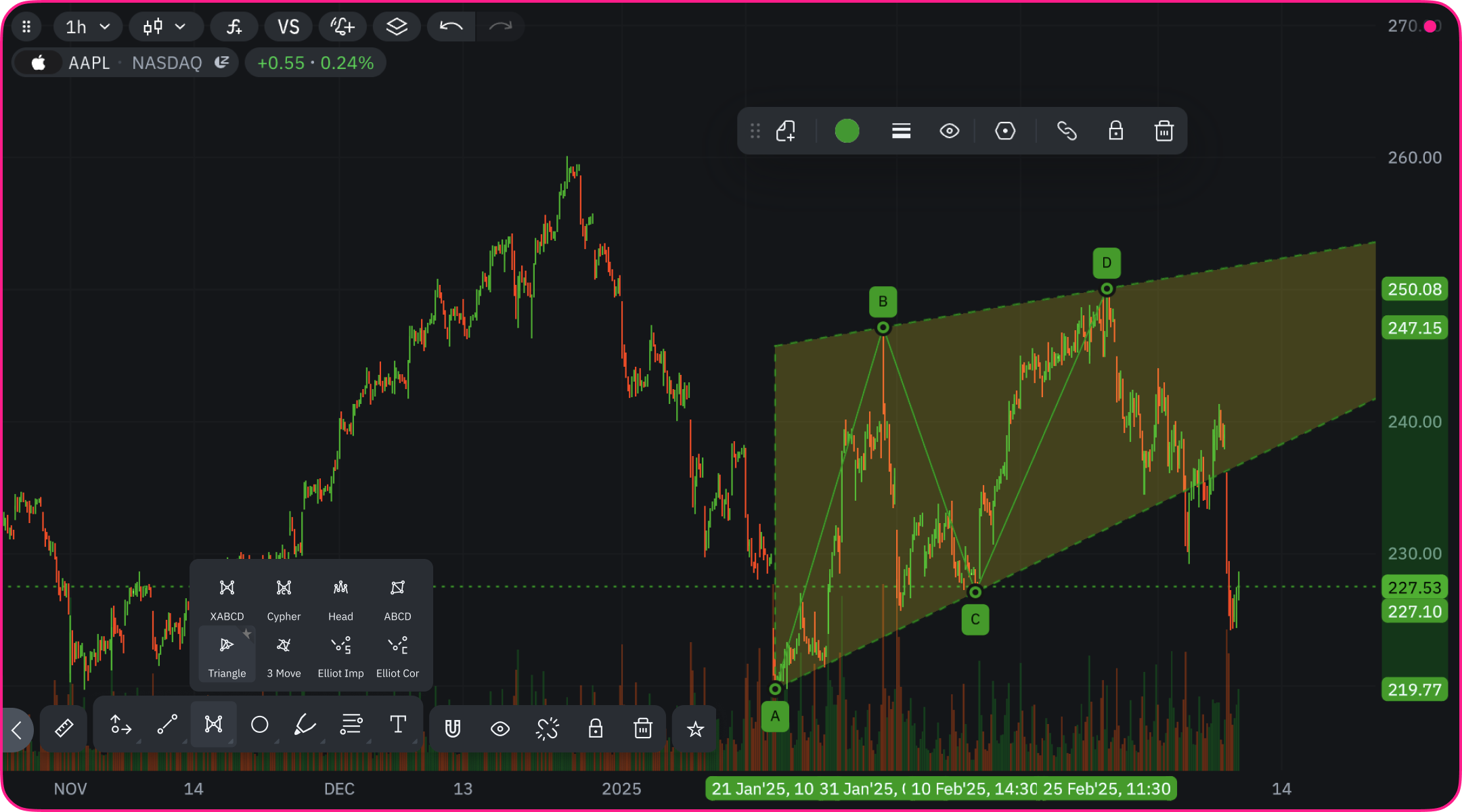 A powerful consolidation pattern indicating potential breakout opportunities:
A powerful consolidation pattern indicating potential breakout opportunities:
- Basic Structure:
- Four control points (A, B, C, D)
- Points placed on alternating highs and lows
- A and C on consecutive highs (or lows)
- B and D on consecutive lows (or highs)
- Creates converging trendlines
- Triangle Variations:
- Symmetrical Triangle:
- Support and resistance lines converge with similar slopes
- Both lines move toward a central apex
- Generally considered a continuation pattern
- Expected breakout in direction of previous trend
- Unexpected breakout direction signals potential trend reversal
- Ascending Triangle:
- AC line forms flat resistance
- BD line forms ascending support
- Bullish pattern suggesting upward pressure
- Expected breakout above resistance line
- False breakouts possible below support line
- Descending Triangle:
- BD line forms flat support
- AC line forms descending resistance
- Bearish pattern suggesting downward pressure
- Expected breakout below support line
- False breakouts possible above resistance line
Three Move Pattern
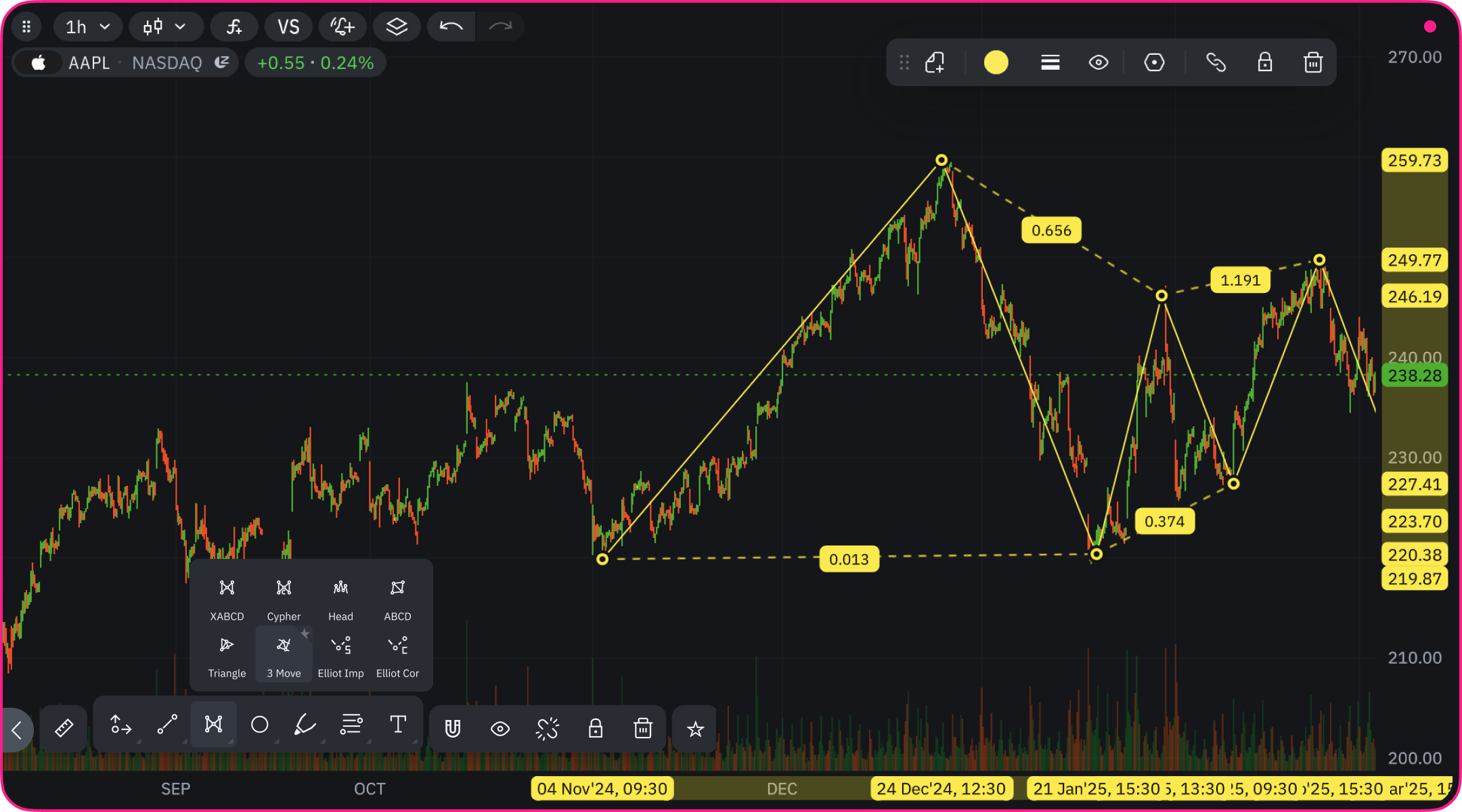 A precise reversal pattern requiring symmetry in both price and time:
A precise reversal pattern requiring symmetry in both price and time:
- Basic Structure:
- Five key points creating three drives and two retracements
- Three drive points (1, 2, 3) following the trend direction
- Two retracement points (A, C) moving counter to the trend
- Complete pattern signals potential trend reversal
- Pattern Requirements:
- Symmetry: Both price movements and time duration must be proportional
- Extensions: Drives 2 and 3 should extend 127.2% or 161.8% of retracements A and C
- Retracements: Points A and C typically retrace 61.8% or 78.6% of previous drives
- In strong trends, may only retrace 38.2% or 50%
- Time Symmetry: Horizontal distance between points should be approximately equal
- Pattern Variations:
- Bullish Three Drives:
- Drives move downward with trend
- Final drive signals potential upward reversal
- Bearish Three Drives:
- Drives move upward with trend
- Final drive signals potential downward reversal
Elliott Impulse and Elliott Correction
A systematic approach to market cycles based on Ralph Nelson Elliott’s wave theory:
- Basic Concept:
- Markets move in predictable, repeating wave patterns driven by human psychology
- The fundamental pattern consists of 8 waves (5 impulse waves followed by 3 corrective waves)
- These patterns appear at all scales, from minute-by-minute charts to multi-year trends
- Elliott discovered that larger waves contain smaller waves with the same structure (fractal nature)
- Wave Classifications:
- Elliott Impulse (Motive Waves):
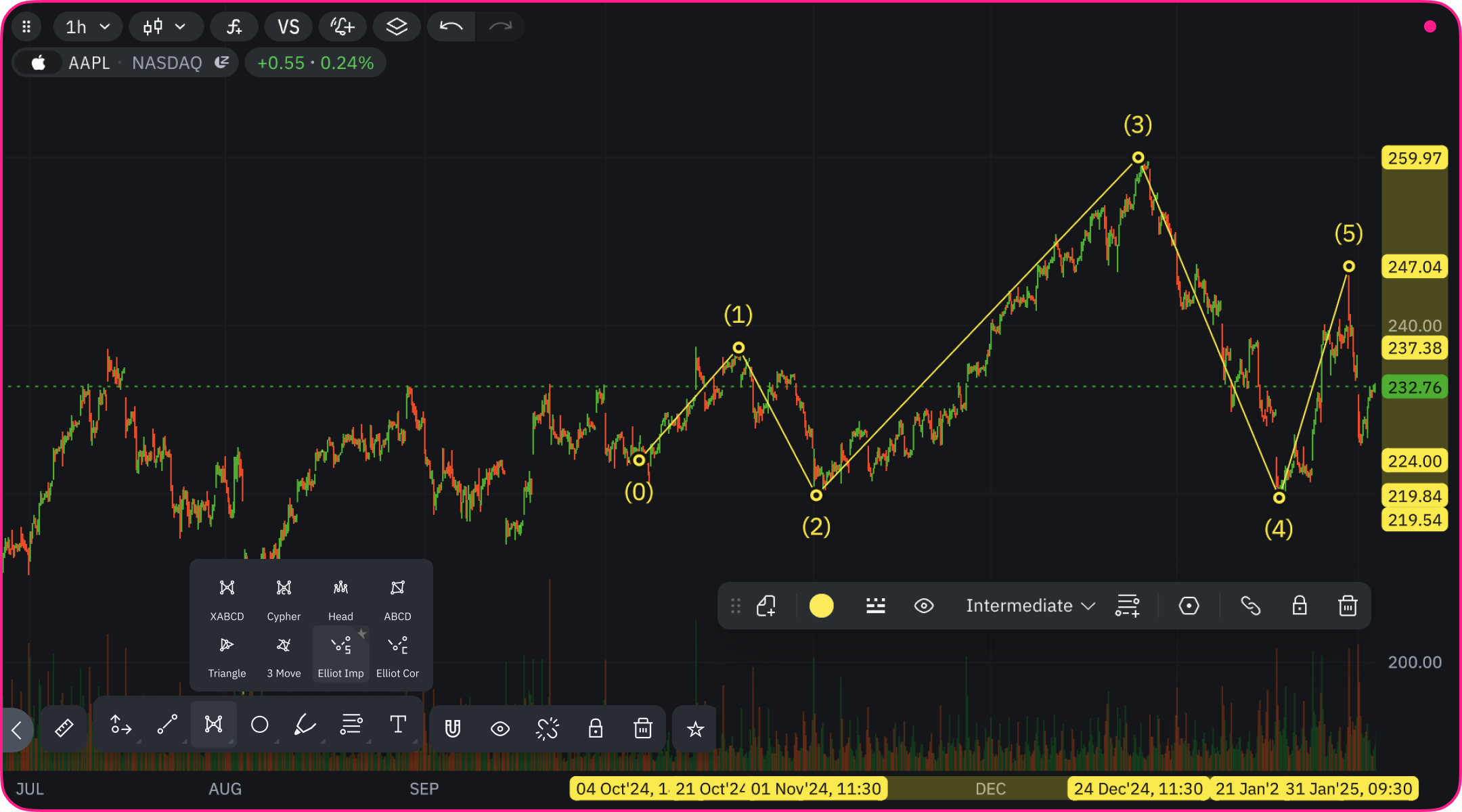
- Move in the direction of the main trend
- Consist of five distinct waves labeled 1-2-3-4-5
- Generally stronger and longer than corrective waves
- Create the primary movement in the market
- Elliott Correction (Corrective Waves):
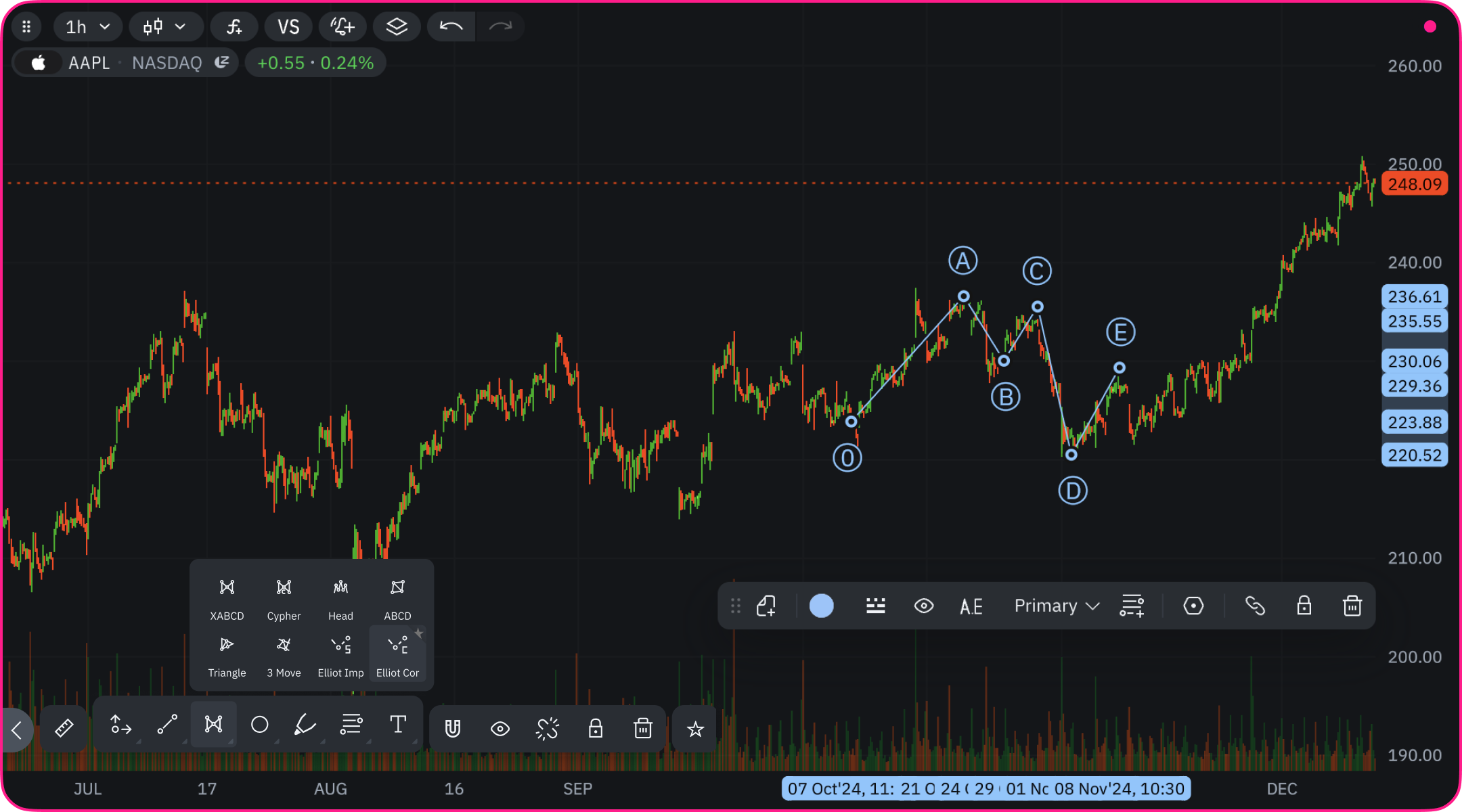
- Move against the main trend direction
- Consist of three distinct waves labeled A-B-C
- Typically retrace a portion of the preceding impulse wave
- Often more complex and difficult to identify than impulse waves
- Elliott Impulse Structure (5 waves):
- Wave Structure: Each impulse consists of 5 waves, with waves 1, 3, and 5 being impulses themselves, and waves 2 and 4 being corrections
- Wave 2 Limitation: The second wave never retraces more than 100% of wave 1 (never goes beyond the starting point of wave 1)
- Wave 3 Extension: The third wave always moves beyond the end of wave 1, often the longest and strongest wave
- Wave 3 Prominence: Among waves 1, 3, and 5, wave 3 is never the shortest and frequently the longest
- Wave 4 Boundary: The fourth wave typically doesn’t enter the price territory of wave 1 (no overlap)
- Elliott Correction Structure (3 waves):
- ZigZag Formation: The most common corrective pattern is a zigzag structured as 5-3-5 (five waves down, three waves up, five waves down in a bearish market)
- Wave B Characteristics: Wave B is typically shorter than wave A, showing the underlying strength of the main trend
- Wave C Extension: Wave C usually extends beyond the end of wave A, creating a new extreme in the correction
- Wave Hierarchy Notation:
- Main Waves: Marked as (1), (2), (3), (4), (5), (A), (B), (C) showing the larger degree pattern
- Sub-waves: Marked as 1, 2, 3, 4, 5, a, b, c representing smaller waves inside the main waves
- Analysis Scope: The pattern typically examines 600 previous bars to identify wave structures
Learn More: For a comprehensive guide on Elliott Impulses with detailed examples and trading strategies, check out our in-depth tutorial at MTC Education - Elliott Impulses. 






